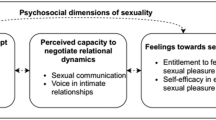Abstract
The differences between male and female adolescents' emotional reactions to their most recent occasion of sexual intercourse were examined. The sample included 932 sexually active Australian secondary school students who completed a self-report questionnaire concerning their sexual behavior. The majority of young people reported that they felt happy or good following their most recent occasion of sex. Females were more likely than males to report negative emotions such as feeling bad and used, but there was no difference between the percentage of males and the percentage of females who reported feeling guilty. Girls were more likely to feel bad, used, or guilty last time if they were drunk/high or had sex with someone who was not a steady partner. Boys who had sex with someone other than a steady partner last time were more likely to feel guilty. Peer and parental influences were also associated with feelings of guilt. Girls who were more confident that they could talk to one of their parents/guardians about sex, and boys who believed that most of their peers were sexually active, were less likely to have felt guilty.
Similar content being viewed by others
References
Carroll, J. L., Volk, K. D., and Hyde, J. S. (1985). Differences between males and females in motives for engaging in sexual intercourse.Arch. Sex. Behav. 14: 131–139.
Centers for Disease Control and Prevention. (1992). Selected behaviors that increase risk for HIV infection, other sexually transmitted diseases, and unintended pregnancies among high school students—United States.JAMA 269: 329–330.
Darling, C. A., and Davidson, J. K. (1986). Coitally active university students: Sexual behaviors, concerns and challenges.Adolescence 21: 403–419.
Darling, C. A., Davidson, J. K., and Passarello, L. C. (1992). The mystique of first intercourse among college youth: The role of partners, contraceptive practices, and psychological reactions.J. Youth Adoles. 21: 97–117.
Donald, M., Lucke, J. C., Dunne, M. P., O'Toole, B., and Raphael, B. (1994). Determinants of condom use by Australian secondary school students.J. Adoles. Health 15: 503–510.
Dunne, M. P., Donald, M., Lucke, J. C., Nilsson, R., Ballard, R., and Raphael, B. (1994). Age-related increase in sexual behaviors and decrease in regular condom use among adolescents in Australia.Int. J. STDs AIDS 5: 41–47.
Eastman, W. F. (1972). First intercourse.Sex. Behav. 2: 22–27.
Fife-Schaw, C. R., and Breakwell, G. M. (1992). Estimating sexual behavior parameters in the light of AIDS: A review of recent UK studies of young people.AIDS Care 4: 187–201.
Kann, L., Anderson, J. E., Holtzman, D., Ross, J., Truman, B. I., Collins, J., and Kolbe, L. J. (1991). HIV related knowledge, beliefs and behaviors among high school students in the United States: Results from a national survey.J. School Health 61: 397–401.
Lucke, J. C., Dunne, M. P., Donald, M., and Raphael, B. (1993). Knowledge of STDs and perceived risk: A study of Australian youth.Venereology 6: 57–63.
Schofield, M. (1973).The Sexual Behavior of Young Adults. Little Brown, Boston.
Sorenson, R. C. (1973).Adolescent Sexuality in Contemporary America. World, New York.
Strunin, L., and Hingson, R. (1992). Alcohol, drugs, and adolescents sexual behavior.Int. J. Addict. 27: 129–146.
Weis, D. L. (1983). Affective reactions of women to their initial experience of coitus.J. Sex Res. 19: 209–237.
Wright, S. M., Gabb, R. G., and Ryan, M. M. (1991). Reproductive health: Knowledge attitudes and needs of adolescents.Med. J. Aust. 155: 325–328.
Zabin, L. S., Hirsch, M. B., Smith, E. A., and Hardy, J. B. (1984). Adolescent sexual attitudes and behavior: Are they consistent?Family Plan. Perspect. 16: 181–185.
Author information
Authors and Affiliations
Additional information
Received B.A. (Hons) from University of Queensland. Research interests include adolescents mental and sexual health.
Received B.A.(Hons) from University of Queensland. Interested in the areas of sex roles and sexual behavior among adolescents.
Received Ph.D. from Murdoch University. Research interests include population studies of sexual behavior and mental health.
Received M.B.B.S., M.D. from University of Sydney. Research interests include adolescent health, psychological response in disasters, coping with grief and loss and living with HIV/AIDS.
Rights and permissions
About this article
Cite this article
Donald, M., Lucke, J., Dunne, M. et al. Gender differences associated with young people's emotional reactions to sexual intercourse. J Youth Adolescence 24, 453–464 (1995). https://doi.org/10.1007/BF01537191
Received:
Accepted:
Issue Date:
DOI: https://doi.org/10.1007/BF01537191




